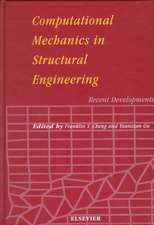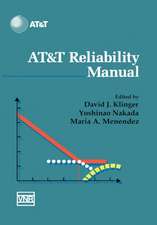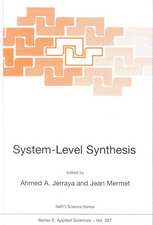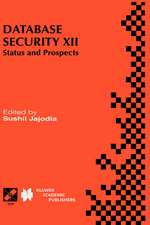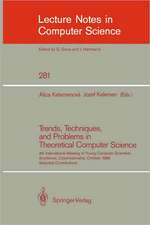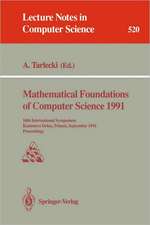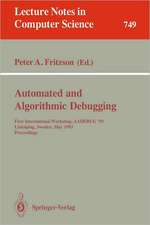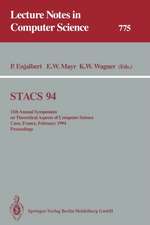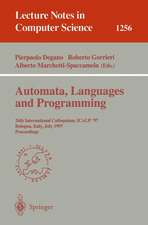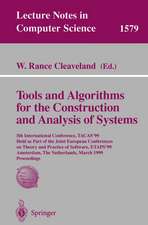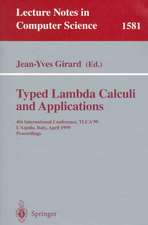Cellular Automata: 11th International Conference on Cellular Automata for Research and Industry, ACRI 2014, Krakow, Poland, September 22-25, 2014, Proceedings: Lecture Notes in Computer Science, cartea 8751
Editat de Jaroslaw Was, Georgios Sirakoulis, Stefania Bandinien Limba Engleză Paperback – 5 sep 2014
Din seria Lecture Notes in Computer Science
- 20%
 Preț: 1061.55 lei
Preț: 1061.55 lei - 20%
 Preț: 340.32 lei
Preț: 340.32 lei - 20%
 Preț: 341.95 lei
Preț: 341.95 lei - 20%
 Preț: 453.32 lei
Preț: 453.32 lei - 20%
 Preț: 238.01 lei
Preț: 238.01 lei - 20%
 Preț: 340.32 lei
Preț: 340.32 lei - 20%
 Preț: 438.69 lei
Preț: 438.69 lei -
 Preț: 449.57 lei
Preț: 449.57 lei - 20%
 Preț: 343.62 lei
Preț: 343.62 lei - 20%
 Preț: 148.66 lei
Preț: 148.66 lei - 20%
 Preț: 310.26 lei
Preț: 310.26 lei - 20%
 Preț: 256.27 lei
Preț: 256.27 lei - 20%
 Preț: 645.28 lei
Preț: 645.28 lei - 17%
 Preț: 427.22 lei
Preț: 427.22 lei - 20%
 Preț: 655.02 lei
Preț: 655.02 lei - 20%
 Preț: 307.71 lei
Preț: 307.71 lei - 20%
 Preț: 1075.26 lei
Preț: 1075.26 lei - 20%
 Preț: 591.51 lei
Preț: 591.51 lei -
 Preț: 381.21 lei
Preț: 381.21 lei - 20%
 Preț: 337.00 lei
Preț: 337.00 lei - 15%
 Preț: 438.59 lei
Preț: 438.59 lei - 20%
 Preț: 607.39 lei
Preț: 607.39 lei - 20%
 Preț: 538.29 lei
Preț: 538.29 lei -
 Preț: 389.48 lei
Preț: 389.48 lei - 20%
 Preț: 326.98 lei
Preț: 326.98 lei - 20%
 Preț: 1414.79 lei
Preț: 1414.79 lei - 20%
 Preț: 1024.44 lei
Preț: 1024.44 lei - 20%
 Preț: 579.30 lei
Preț: 579.30 lei - 20%
 Preț: 575.48 lei
Preț: 575.48 lei - 20%
 Preț: 583.40 lei
Preț: 583.40 lei - 20%
 Preț: 763.23 lei
Preț: 763.23 lei - 15%
 Preț: 580.46 lei
Preț: 580.46 lei - 17%
 Preț: 360.19 lei
Preț: 360.19 lei - 20%
 Preț: 504.57 lei
Preț: 504.57 lei - 20%
 Preț: 172.69 lei
Preț: 172.69 lei - 20%
 Preț: 369.12 lei
Preț: 369.12 lei - 20%
 Preț: 353.50 lei
Preț: 353.50 lei - 20%
 Preț: 585.88 lei
Preț: 585.88 lei -
 Preț: 410.88 lei
Preț: 410.88 lei - 20%
 Preț: 596.46 lei
Preț: 596.46 lei - 20%
 Preț: 763.23 lei
Preț: 763.23 lei - 20%
 Preț: 825.93 lei
Preț: 825.93 lei - 20%
 Preț: 649.49 lei
Preț: 649.49 lei - 20%
 Preț: 350.21 lei
Preț: 350.21 lei - 20%
 Preț: 309.90 lei
Preț: 309.90 lei - 20%
 Preț: 122.89 lei
Preț: 122.89 lei
Preț: 353.83 lei
Preț vechi: 442.29 lei
-20% Nou
Puncte Express: 531
Preț estimativ în valută:
67.71€ • 70.78$ • 57.22£
67.71€ • 70.78$ • 57.22£
Carte tipărită la comandă
Livrare economică 06-20 martie
Preluare comenzi: 021 569.72.76
Specificații
ISBN-13: 9783319115191
ISBN-10: 3319115197
Pagini: 713
Ilustrații: XX, 713 p. 350 illus.
Dimensiuni: 155 x 235 x 43 mm
Greutate: 1.01 kg
Ediția:2014
Editura: Springer International Publishing
Colecția Springer
Seriile Lecture Notes in Computer Science, Theoretical Computer Science and General Issues
Locul publicării:Cham, Switzerland
ISBN-10: 3319115197
Pagini: 713
Ilustrații: XX, 713 p. 350 illus.
Dimensiuni: 155 x 235 x 43 mm
Greutate: 1.01 kg
Ediția:2014
Editura: Springer International Publishing
Colecția Springer
Seriile Lecture Notes in Computer Science, Theoretical Computer Science and General Issues
Locul publicării:Cham, Switzerland
Public țintă
ResearchCuprins
Conductivity, Memristivity and Creativity in Cellular Automata.- Automata Formalism.- Towards a Comprehensive Understanding of Multi-state CellularAutomata.- Iterative Arrays with Set Storage.- Isotropic Cellular Automaton for Excitable Media with Random Neighbor Selection.- Power Spectral Analysis of the Computation Process by Rule 110.- Cellular Automata and Formulae on Monoids.- A Scalable Method for Constructing Non-linear Cellular Automata with Period 2n − 1.- Systolic Dissemination in the Arrowhead Family.- Cellular Automata Dynamics and SynchronizationOn the Dynamics of Multi-information in Cellular Automata.- Lyapunov Exponents of One-Dimensional, Binary Stochastic Cellular Automata.- Synthesis of Non-uniform Cellular Automata Having only Point Attractors.- Non Uniform Cellular Automata Description of Signed Partition Versions of Ice and Sand Pile Models.- Variable Entangling in a Quantum Battle of the Sexes Cellular Automaton.- Experimental Finitization of Infinite Field-Based Generalized FSSP Solution.- Cellular Automata (CA) Model for Primality Test.- Numerical Modelling of Fracture Based on Coupled Cellular AutomataFinite Element Approach.- Two-Layer CA Model for Simulating Catalytic Reaction at Dynamically Varying Temperature.- Modelling Ordered Nanopourous Structures by Anodization via Cellular Automata.- Overview of Cellular Automaton Models for Corrosion.- Cellular Automata Finite Element Approach for Modelling Microstructure Evolution under Thermo-Mechanical Processing Conditions.- A Preliminary Cellular Model for Secondary Lahars and Simulation of 2005 Case of Vascun Valley, Ecuador.- Vulnerability and Protector Control: Cellular Automata Approach.- UNDATA: A Preliminary Cellular Automata Model for Tsunami Simulation.- Modeling Rainfall Features Dynamics in a DEM Satellite Image withCellular Automata.- Cellular Automata Model with Game Theory for Power Management of Hybrid Renewable Energy Smart Grids.- A Novel Algorithm for Coarse-Grainingof Cellular Automata.- Cellular Automata Model for Protein Structure Synthesis (PSS).- The Basic Reproduction Number for Chagas Disease Transmission Using Cellular Automata.- Modelling Spatial Distribution of the Barents Sea Cod Fishery.- Training Cellular Automata to Simulate Urban Dynamics: A Computational Study Based on GPGPU and Swarm Intelligence.- Cellular Automaton Approach to Arching in Two-Dimensional Granular Media.- Modeling of Friction Dynamic Motion by Cellular Automata.- Agent Based Simulation of Spreading in Social-Systems of Temporarily Active Actors.- Cellular Automata for Modeling Language Change.- Sznajd Model with Memory.- Detecting Emergent Phenomena in Cellular Automata Using Temporal Description Logics.- Cellular Automata-Based Hardware and Computing Direction-Reversible Self-Timed Cellular Automata for Delay-Insensitive Circuits.- Implementation of a Cellular Automaton with Globally Switchable Rules.- Highly Compact Automated Implementation of Linear CA on FPGAs.- Shortest Path Computing Using Memristor-Based Circuits and Cellular Automata.- Cryptography, Networks and Pattern Classification with Cellular Automata Generation of TPMACA for Pattern Classification.- Sharing Secrets by Computing Preimages of Bipermutive Cellular Automata.- Inapplicability of Fault Attacks against Trivium on a Cellular Automata Based Stream Cipher.- Cellular Automata Approach to Maximum Lifetime Coverage Problem in Wireless Sensor Networks.- C and CA - Int. Workshop on Crowds and Cellular AutomataApplication of NIST Technical Note 1822 to CA Crowd Dynamics Models Verification and Validation.- Effect of Group Behavior on Crowd Dynamics.- Effects of Boundary Conditions on Single-File Pedestrian Flow.- Simulation Study of the Spiral Motion of Pedestrians: A Cellular Automata Approach.- CA Crowd Modeling for a Retirement House Evacuation with Guidance.- Multiscale Simulation of Pedestrians for Faster Than Real Time Modeling in Large Events.- Cellular Automata Pedestrian Movement Model SIgMA.CA:Model Parameters as an Instrument to Regulate Movement Regimes.- Case Study of Phase Transition in Cellular Models of Pedestrian Flow.- Simulation of Public Opinion with Ideas of Cellular Automata.- Estimating Speeds of Pedestrians in Real-World Using Computer Vision.- Geometric Characterization of Hereditarily Bijective Boolean Networks.- Inner-Independent Radius-Dependent Totalistic Rule of Universal Asynchronous Cellular Automaton.- Bifurcations of Local Structure Maps as Predictors of Phase Transitions in Asynchronous Cellular Automata.- Computing Symbolic Steady States of Boolean Networks.- Equivalences in Multi-valued Asynchronous Models of Regulatory Networks.- Effective Parallelism Rate by Reversible PCA Dynamics.- Quick Convergence to a Fixed Point: A Note on Asynchronous Elementary Cellular Automata.- A Study of Aggregated Speed in Road Networks Using Cellular Automata.- A New Cellular Automaton Model with Spatiotemporal Process of Lane Changing Execution.- Cellular Automaton Model with Non-hypothetical Congested Steady State Reproducing the Three-Phase Traffic Flow Theory.- Asymmetric Lane Change Rules for a Microscopic Highway TrafficModel.- Interactions between Multiple Junctions.- Modeling Disruption and Recovery of Traffic in Road Networks.- Simulation of Pedestrians Behavior in a Shopping Mall.- How Agents Can Form a Specific Pattern.- An Integrated Model for the Simulation of Pedestrian Crossings.- Agent-Based Pedestrian Activity Simulation in Shopping Environments Using a Choice Network Approach.- Software Implementation of Population of Cognitive Agents Learning to Cross a Highway.- The Effects of Supraregional Innovation and Production Collaboration on Technology Development in a Multiregional World: A Spatial Agent-Based Model Study.

